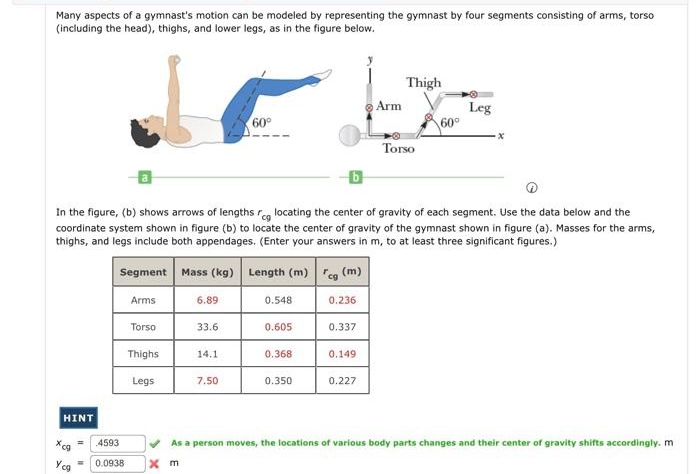Many aspects of a gymnast's motion can be modeled by representing the gymnast by four segments consisting of arms, torso (including the head), thighs, and lower legs, as in the figure below. Thigh Arm Leg 60° 60° ·x Torso b In the figure, (b) shows arrows of lengths reg locating the center of gravity of each segment. Use the data below and the coordinate system shown in figure (b) to locate the center of gravity of the gymnast shown in figure (a). Masses for the arms, thighs, and legs include both appendages. (Enter your answers in m, to at least three significant figures.) Segment Mass (kg) Length (m) cg (m) Arms 6.89 0.548 0.236 Torso 33.6 0.605 0.337 Thighs 14.1 0.368 0.149 Legs 7.50 0.350 0.227 As a person moves, the locations of various body parts changes and their center of gravity shifts accordingly. m xm HINT xc9 Ycq 4593 0.0938
Many aspects of a gymnast's motion can be modeled by representing the gymnast by four segments consisting of arms, torso (including the head), thighs, and lower legs, as in the figure below. Thigh Arm Leg 60° 60° ·x Torso b In the figure, (b) shows arrows of lengths reg locating the center of gravity of each segment. Use the data below and the coordinate system shown in figure (b) to locate the center of gravity of the gymnast shown in figure (a). Masses for the arms, thighs, and legs include both appendages. (Enter your answers in m, to at least three significant figures.) Segment Mass (kg) Length (m) cg (m) Arms 6.89 0.548 0.236 Torso 33.6 0.605 0.337 Thighs 14.1 0.368 0.149 Legs 7.50 0.350 0.227 As a person moves, the locations of various body parts changes and their center of gravity shifts accordingly. m xm HINT xc9 Ycq 4593 0.0938
International Edition---engineering Mechanics: Statics, 4th Edition
4th Edition
ISBN:9781305501607
Author:Andrew Pytel And Jaan Kiusalaas
Publisher:Andrew Pytel And Jaan Kiusalaas
Chapter1: Introduction To Statics
Section: Chapter Questions
Problem 1.12P: A differential equation encountered in the vibration of beams is d4ydx4=2D where x = distance...
Related questions
Question
T5

Transcribed Image Text:Many aspects of a gymnast's motion can be modeled by representing the gymnast by four segments consisting of arms, torso
(including the head), thighs, and lower legs, as in the figure below.
Thigh
JE
Arm
Leg
60°
60°
Torso
In the figure, (b) shows arrows of lengths reg locating the center of gravity of each segment. Use the data below and the
coordinate system shown in figure (b) to locate the center of gravity of the gymnast shown in figure (a). Masses for the arms,
thighs, and legs include both appendages. (Enter your answers in m, to at least three significant figures.)
Segment Mass (kg) Length (m) Fcg (m)
Arms
6.89
0.548
0.236
Torso
33.6
0.605
0.337
Thighs
14.1
0.368
0.149
Legs
7.50
0.350
0.227
As a person moves, the locations of various body parts changes and their center of gravity shifts accordingly. m
x m
HINT
xc9
Ycg
4593
0.0938
Expert Solution
This question has been solved!
Explore an expertly crafted, step-by-step solution for a thorough understanding of key concepts.
This is a popular solution!
Trending now
This is a popular solution!
Step by step
Solved in 3 steps with 2 images

Knowledge Booster
Learn more about
Need a deep-dive on the concept behind this application? Look no further. Learn more about this topic, mechanical-engineering and related others by exploring similar questions and additional content below.Recommended textbooks for you

International Edition---engineering Mechanics: St…
Mechanical Engineering
ISBN:
9781305501607
Author:
Andrew Pytel And Jaan Kiusalaas
Publisher:
CENGAGE L

Principles of Heat Transfer (Activate Learning wi…
Mechanical Engineering
ISBN:
9781305387102
Author:
Kreith, Frank; Manglik, Raj M.
Publisher:
Cengage Learning

International Edition---engineering Mechanics: St…
Mechanical Engineering
ISBN:
9781305501607
Author:
Andrew Pytel And Jaan Kiusalaas
Publisher:
CENGAGE L

Principles of Heat Transfer (Activate Learning wi…
Mechanical Engineering
ISBN:
9781305387102
Author:
Kreith, Frank; Manglik, Raj M.
Publisher:
Cengage Learning